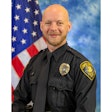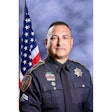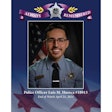A few more inches and that guy could have killed me.
As a Washington State Trooper, Kelly Kalmbach had been given her fair share of adrenaline jolts courtesy of other drivers. But few had come so close to taking her out as the driver of a white Cadillac that nearly clipped her patrol car around midnight June 25, 2006, on State Route 7 near Spanaway. Through the years the absence of a center median barrier wall along this highway had proven fateful for other Pierce County motorists, so Kalmbach knew it was up to her to stop this guy before he killed someone.
Kalmbach activated her emergency red lights and made a U-turn onto the southbound lanes in pursuit of the Cadillac.
I Have a Gun
The Cadillac drifted across two lanes then quickly turned into a gas station. It stopped abreast of the gasoline pumps, and Kalmbach pulled up behind it. She ran the license plate over her radio but, before she could copy a return, the driver side door of the Cadillac opened and the driver began to step out.
Kalmbach quickly exited her patrol car and yelled for the driver to stop what he was doing and keep his hands in plain view.
The clean-cut driver, later identified as 24-year-old Jack Sonntag, complied. But as Kalmbach moved toward the Cadillac, he suddenly said, "I have a gun."
Kalmbach pulled up short and drew her sidearm.
"Where?"
"It's in my waistband."
Consciously foregoing a request for backup, Kalmbach safely retrieved the firearm—a 9mm Ruger—from Sonntag's waistband. She didn't want to give Sonntag time to embolden himself to do something stupid.
"I have a permit," Sonntag explained, a familiar odor trailing on his breath.
Paperwork found in the Cadillac verified Sonntag's carry permit. Still, vehicle stops are inherently volatile situations—moreso when the detainee has been drinking—and the last variable Kalmbach wanted to add to the mix was a firearm.
Isolating the Ruger in the trunk of her vehicle for the duration of the detention would have been the trooper's preference. But Kalmbach didn't want to run the risk of getting a complaint for seizing a permitted firearm. She decided to secure the pistol inside the passenger compartment area of Sonntag's Cadillac pending the outcome of his field sobriety test.
This decision would prove to be fateful.
Front-Page News
Sonntag pleaded for parking lot amnesty.
"Come on," he asked. "Give me a break. I'm only two blocks from home."
Kalmbach wasn't one for cutting breaks to drunk drivers. Seventeen years as a police dispatcher had predisposed her against such leniency; an additional seven years of working patrol and witnessing the carnage wrought by drunks on the road had only calcified her bias. She asked Sonntag to perform a series of field sobriety tests.
Sonntag's frustrated attempts to successfully perform the tests readily confirmed Kalmbach's suspicions.
To look at Sonntag, one wouldn't be particularly intimidated. Certainly nothing in his lineage would have suggested any potential trouble. The son of a former Tacoma city councilman and nephew of a state auditor, he wasn't on parole or probation. He was polite and respectful to Kalmbach.
What Kalmbach couldn't have predicted was Sonntag's darker side. What he lacked in criminal pedigree, he made up for in swagger. Sonntag took great pride in his ability to carry a firearm and greater pains to display it. He'd made a habit of telling friends and relatives that he would never be taken under arrest.
"And if they try and take me," Sonntag had promised, "it'll be front-page news."
Perhaps he truly believed his own words. Maybe he felt obligated to live up to them. For Sonntag suddenly darted back to the Cadillac.
First Blood
Kalmbach couldn't believe it. All the compliance that Sonntag had displayed had disappeared in a split second. Determined to incapacitate Sonntag with less-lethal force before he could re-enter the vehicle, Kalmbach set off in foot pursuit, yelling "TASER! TASER! TASER!"
Kalmbach closed the gap between herself and the suspect and activated the TASER, but suddenly it was Kalmbach who felt fire coursing through the veins of her left arm.
She never saw the ballistic flash, never heard the distinctive report. But Kalmbach immediately knew one thing: She'd been shot.
How Sonntag could have retrieved the firearm so quickly was beyond Kalmbach's comprehension. She did understand one thing all too well: The situation had suddenly turned into a life or death one, one wherein the suspect had drawn first blood.
Marooned between the two vehicles, Kalmbach discarded her TASER and retreated for the passenger side of her patrol car for cover. As she moved, she drew her H&K .40 caliber sidearm and returned fire. Sonntag was still shooting at her from the open door of his Caddy.
Using her engine block for cover, Kalmbach continued to engage the suspect as she squatted in a modified Weaver stance, her incapacitated left arm hanging down and her right arm fully extended and firing. But the rapid fire of her weapon garnered no visible effect.
Sonntag remained standing inside his driver's door, everything about his body completely immobile save for the finger on the trigger. That was working overtime.
Hoping that she could suppress his fire, Kalmbach squeezed as many rounds at Sonntag's center mass as she could.
I Will Survive
Suddenly, the suspect stopped firing and dropped into the driver's seat. Putting the Cadillac in gear, Sonntag smashed against a pump guard rail as he accelerated in a wide swath and drove past the rear of Kalmbach's patrol car.
That son-of-a-bitch might take off, thought Kalmbach. But he's not going to get far.
And with that, Kalmbach took aim and fired at the suspect's left front tire. The Cadillac sped off down State Route 7.
As intense as it had been sudden, as short as it had been inexplicable, the firefight was over. Now Kalmbach found herself in round two of the fight for her life.
Within the span of a few seconds, some twenty rounds had been exchanged between suspect and officer.
A citizen passerby, Laurie Rowley, who'd witnessed the shootout, tied a tourniquet on the downed trooper's arm. It would prove to be a huge factor in Kalmbach's survival. Another was the trooper's mindset.
Kalmbach thought of her family and her obligation to come out of this for them. She recalled the words that she'd recited so many times in the academy: I will not die. I will not quit. I will survive.
Kalmbach had contemplated the possibility of getting shot on duty and wondered how she'd respond to such an incident. She had anticipated pain, but nothing nearly as intense as what she was experiencing. I will not die. I will survive.
That's Him
Only when another officer arrived on scene did Kalmbach allow herself to be seated on the pavement. She retrieved Sonntag's paperwork from where she'd stashed it behind the magazine pouch of her duty belt and tapped at the identification card.
"That's him," she told her fellow officer. "That's the man who shot me."
Seconds later, the suspect's description was broadcast to officers throughout the area who began to search for Jack Sonntag.
Meanwhile, with three of Kalmbach's hollow-point rounds in his chest and his Cadillac disabled with a flat tire, Sonntag called two friends to ask for a ride.
"I'm really scared," Sonntag begged. "Come and pick me up." The only additional information he volunteered was his location: A church parking lot.
The sight of a white Cadillac with a shredded left front tire parked in an empty church parking lot near midnight caught the eyes of two Pierce County sheriff's deputies, Rich Scanzfer and Scott Mock.
Pulling into the lot to investigate, they spotted a man matching the suspect's description emerging from the bushes. The timeline and distance—less than five miles from the site of the shooting—led one of the deputies to yell, "What's your name?"
"Jack!" came the reply. Sonntag leveled a handgun at them.
Scanzfer and Mock fired, and Sonntag fell. Shortly after midnight, he was pronounced dead at the scene by paramedics.
10 Hours of Surgery
Back at Madigan Army Hospital, a fellow officer gently grabbed Kalmbach's shoulder as she was being pulled into the emergency room.
"They got him. He's dead."
Normally, Kalmbach wasn't one to take comfort in the passing of another. But the last thing that she wanted was for this suspect to get the better of another officer, and she couldn't deny the profound sense of relief that washed over her.
But Kalmbach had paid a price, too. Sonntag's rounds had found their mark five times, passing through her left calf, the inside of her right knee, and her right hip. A round in her hip required surgical removal. But the most devastating round had been the first one, which had cut the brachial artery in her left arm.
Some 10 hours of surgery were followed by a slow reemergence into the world of consciousness; lucidity couldn't be claimed until two o'clock the following afternoon. And with it came pain—lots of pain. The combined effects of a morphine drip and pain pills every two hours could do little to abate the sensation of a platoon of red ants feasting on Kalmbach's every nerve. She stared down at the immobilized limb, wondering how something so still could feel like it was bouncing off every wall in the room.
Trooper of the Year
Eventually, the pain tapered off…way off, to the point that her hand had become insensate. As months went by, it became apparent that Kalmbach had suffered extreme nerve damage. Today, her weekly schedule includes an aggressive three-day-a-week physical rehabilitation program. She has dealt successfully with the emotional fallout of the incident, not having so much as a single nightmare.
When she looks back on the shooting, Kalmbach notes what worked out best for her, and what didn't. "I always took my training seriously. I never once went out there like it was 'play day.' I also went to the range as often as three times a month on my own initiative. I may be a gifted athlete, but I'm no marksman. So I made a conscious effort in working to strengthen my weaknesses."
Tactically, she was glad that her training kicked in once the shooting started, and she had the presence of mind to move for cover, as opposed to getting stuck in no man's land. As it turned out, the windshield, passenger door, and the front of the patrol car ended up absorbing four of the suspect's rounds. Absent such protection, Kalmbach doesn't doubt that she would have been struck more times.
Kalmbach has come to appreciate something else: the body's amazing ability to respond to such trauma. Indeed, as the shooting escalated, Kalmbach wasn't even aware that her legs had been shot. The need to respond to the situation completely superseded the momentary debilitating sense of pain.
There's only one thing that she would have done differently.
"I would have secured the firearm, and the hell with any potential complaint," she says.
Kalmbach wants to return to work, but her doctors have not given her any cause for false optimism, and she is learning to live with her impaired nerve endings.
"I've cut myself with gardening shears and didn't know it until I saw blood. I've burned myself, but didn't know until I saw a huge blister later."
Initially reticent to do so, Kalmbach has even agreed to meet with Sonntag's family members. Having lost her own son, she understands the pain the family is going through and feels that it will help bring closure for all involved.
In March, Kalmbach was named North America's Trooper of the Year by the International Association of Chiefs of Police. She was given the Mike Buckingham Award for the courage she displayed in surviving a critical incident, and on May 4, she received the Law Enforcement Medal of Honor.
Kalmbach hasn't had a single negative flashback related to the incident, but she still entertains an occasional thought.
A few more inches, and that guy could have killed me.
Dean Scoville is a patrol supervisor and investigator with the Los Angeles County Sheriff's Department and Associate Editor of POLICE.
What Would You Do?
Consider the circumstances that faced Trooper Kelly Kalmbach when she confronted an apparently intoxicated driver possessing a legally carried firearm. Now ask yourself these questions:
″ How would you handle a citizen contact involving firearms? What is your agency's posture on those situations involving permitted firearms?
″ If you had a subject take flight from you—knowing that he would be putting himself within reach of a firearm by doing so—how would you respond?
″ Do you have a survival mantra? What thoughts or prayers would keep you going if you found yourself badly wounded in a firefight?
















